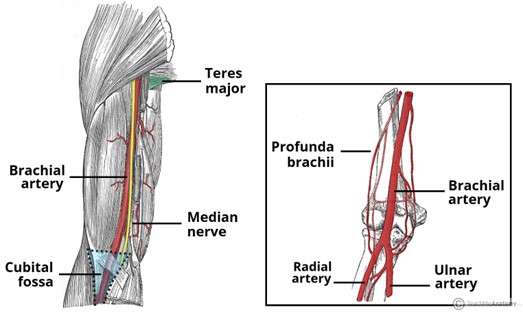A nurse is providing teaching about blood pressure measurement to a client who has hypertension. Which of the following instructions should the nurse include?
Use an electronic device.
Inflate the cuff to 140/90 mmHg.
Place the cuff on the upper arm.
Measure blood pressure after exercise.
The Correct Answer is C
Choice A reason: Using an electronic device is not a reliable method for measuring blood pressure because it may give inaccurate readings due to movement, noise, or battery issues. An electronic device should be calibrated regularly and compared with a manual device.
Choice B reason: Inflating the cuff to 140/90 mmHg is not a correct procedure for measuring blood pressure because it may cause discomfort and false readings. The cuff should be inflated to about 20 to 30 mmHg above the expected systolic pressure or until the pulse disappears.
Choice C reason: Placing the cuff on the upper arm is a correct procedure for measuring blood pressure because it ensures that the cuff is at the same level as the heart and that the brachial artery is compressed. The cuff should be snug and fit around 80% of the arm circumference.
Choice D reason: Measuring blood pressure after exercise is not a good time for measuring blood pressure because it may reflect a temporary increase due to physical activity. Blood pressure should be measured after resting for at least 5 minutes in a quiet and comfortable environment.

Nursing Test Bank
Naxlex Comprehensive Predictor Exams
Related Questions
Correct Answer is C
Explanation
Choice A reason: Using liquids to clear food from the client's mouth is not a safe intervention for dysphagia. Liquids can easily enter the airway and cause aspiration, which is the inhalation of food or fluids into the lungs. Aspiration can lead to pneumonia, respiratory distress, and death.
Choice B reason: Tilting the client's head backwards to facilitate swallowing is not a safe intervention for dysphagia. This position can also increase the risk of aspiration, as it opens the airway and allows food or fluids to flow into it.
Choice C reason: Adding a thickening agent to liquids is a safe and effective intervention for dysphagia. Thickened liquids are easier to swallow and control, as they move more slowly through the mouth and throat. They also reduce the risk of aspiration, as they are less likely to enter the airway.
Choice D reason: Placing the client in a semi-Fowler's position is not a safe intervention for dysphagia. This position can also increase the risk of aspiration, as it lowers the head and neck and reduces the closure of the airway. A better position for dysphagia is upright or high-Fowler's, which elevates the head and neck and enhances the closure of the airway.
Correct Answer is B
Explanation
Choice A reason: Creatinine 1.3 mg/dL is slightly elevated, but it does not indicate fluid volume excess. Creatinine is a waste product of muscle metabolism that is filtered by the kidneys. High creatinine levels can indicate kidney damage or impaired renal function.
Choice B reason: BNP 300 pg/mL is high and indicates fluid volume excess. BNP stands for brain natriuretic peptide, which is a hormone released by the heart when it is stretched by increased blood volume or pressure. High BNP levels can indicate heart failure or fluid overload.
Choice C reason: Potassium 3.5 mEq/L is within the normal range (3.5-5.0), and it does not indicate fluid volume excess. Potassium is an electrolyte that helps regulate nerve and muscle function, especially the heart. Low or high potassium levels can cause cardiac arrhythmias, muscle weakness, or paralysis.
Choice D reason: Sodium 140 mEq/L is within the normal range (135-145), and it does not indicate fluid volume excess. Sodium is an electrolyte that helps maintain fluid balance, blood pressure, and nerve impulses. Low or high sodium levels can cause confusion, seizures, or coma.
Whether you are a student looking to ace your exams or a practicing nurse seeking to enhance your expertise , our nursing education contents will empower you with the confidence and competence to make a difference in the lives of patients and become a respected leader in the healthcare field.
Visit Naxlex, invest in your future and unlock endless possibilities with our unparalleled nursing education contents today
Report Wrong Answer on the Current Question
Do you disagree with the answer? If yes, what is your expected answer? Explain.
Kindly be descriptive with the issue you are facing.
